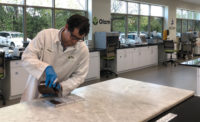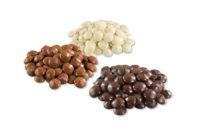Compound coatings trends: Chocolatey coatings take on new roles
Versatile, cost-efficient and easy to use, a compound coating is the ingredient to consider when it comes to finding alternatives to true chocolate.




Chocolate connoisseurs may delight in the “melt-in-your-mouth” quality that chocolate has, but sometimes a compound coating is just as delectable.
A compound coating is a variation of chocolate that does not adhere completely to the Code of Federal Regulations Standard of Identity for chocolate, which has strict guidelines for milk, dark and white chocolates. Specifically, true chocolate must be made with cocoa butter. However, compound coatings are usually made with vegetable oil instead, and they can be found in a variety of application forms, including coatings, drizzles, chunks and drops.
“A compound is a blend of sugar, vegetable oil and other products, which may or may not include cocoa powder or chocolate liquor,” says Stacy Reed, product development manager, Cargill Cocoa & Chocolate.
A compound coating usually comes in chip, melt or disk form for easy packaging, transport and use, according to a blog post by Sephra. They can be made into any shape, however, and can come in large bars or in liquid form.
While the cocoa butter in true chocolate melts at human body temperature, the vegetable oil used in a compound coating allows for a range of melt points. That makes it easy to use in applications of all sorts. Vegetable oil is also cheaper than cocoa butter, making a compound coating a cost-efficient alternative to true chocolate.
It’s commonly used to make moulded candies, substitute for couverture chocolate as well as create dipped snacks like chocolate-dipped strawberries and cookies. Because a compound coating has a higher melt point than chocolate, it doesn’t require tempering to achieve the desired finish and mouth feel.
That makes a compound coating a less “fussy” ingredient to work with. While true chocolate must be treated properly to avoid fat bloom, compounds harden within moments of leaving a heat source, allowing them to create a firm coating on dipped items.
A compound coating also holds up better to supply chain and production demands because of its higher melt point, says Reed.
Although texture can be a challenge when creating a compound coating, it makes up for that by being extremely versatile.
“Depending upon the vegetable oil system and melt point, the compound can get waxy in texture and mouth feel,” says Reed. “On the plus side, compound coatings come in a seemingly endless variety of colors, flavors and melt points.”
It’s also not limited to chocolate. Without the requirement for cocoa butter, a compound coating can come in any color or flavor its creators can dream up.
“Any number of compound coatings can be developed with a variety of flavors, colors and performance levels based on the fat system used,” says Reed.
They’ve also started to follow industry trends.
Targeting the health and wellness trend, one of the biggest innovations in the compound space is the development of functional compounds, says Reed. By adding vitamins, minerals and protein sources, suppliers like Cargill can provide customers with different options for their compound needs.
Thanks to the versatility of compounds in combining flavors, colors and additives, it will continue to be an area to grow and innovate in. Basically, the chocolaty possibilities are endless.
Looking for a reprint of this article?
From high-res PDFs to custom plaques, order your copy today!









